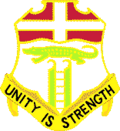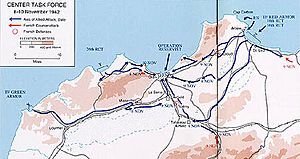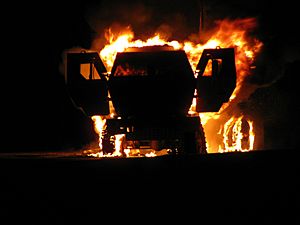6th Infantry Regiment (United States) facts for kids
Quick facts for kids 6th Infantry Regiment |
|
|---|---|

6th Infantry coat of arms
|
|
| Active | 1812–present |
| Country | |
| Branch | |
| Type | Infantry |
| Garrison/HQ | Ft. Bliss, Texas |
| Nickname(s) | "Regulars" |
| Motto(s) | Unity is Strength |
| Engagements | War of 1812 Mexican–American War American Civil War Indian Wars War with Spain Philippine–American War Mexican Expedition World War I World War II Vietnam War Panama War in Southwest Asia Iraq Campaign |
| Commanders | |
| Notable commanders |
Zachary Taylor Henry W. Wessells Norman Schwarzkopf (1st BN) Carter Ham(1st BN) Courtney Hodges |
| Insignia | |
| Distinctive unit insignia |  |
The 6th Infantry Regiment, also known as the "Regulars," was created on January 11, 1812. A famous leader of this unit was Zachary Taylor, who later became the twelfth President of the United States. The regiment's motto, "Regulars, By God!", comes from a battle during the War of 1812. During the Battle of Chippawa, a British general saw the American soldiers approaching. He thought they were just local militia, who were usually easier to defeat. But when the Americans bravely attacked, he supposedly said, "Those are Regulars, By God!" This showed how tough and well-trained the regiment was.
Contents
A History of Service
The 6th Infantry Regiment has taken part in many important conflicts throughout American history. They fought in the War of 1812, the Mexican–American War, and the American Civil War. They were also involved in the American Indian Wars from 1823 to 1879. Later, they served in the Spanish–American War and the Philippine–American War.
In the 20th century, the regiment saw action in the Pancho Villa Expedition in Mexico. They played a role in both World War I and World War II. Later, they served in the Vietnam War. Parts of the 6th Infantry were also sent to Bosnia and Herzegovina to help keep the peace. In 1989, the 4th Battalion helped in Operation Just Cause in Panama. The 1st Battalion went to Macedonia in 1994 for a peacekeeping mission. They also deployed to Albania and Kosovo in 1999.
In the 21st century, the 6th Infantry Regiment was heavily involved in the Iraq War. They were among the first units to arrive in Baghdad in 2003. They returned to Iraq for more missions in 2005, 2008, 2009, and 2011. In 2011, the 4th Battalion was one of the last U.S. Army units to leave Iraq. Today, two battalions of the 6th Infantry Regiment are part of the 1st Armored Division.
Early Years and Wars
The 6th Infantry Regiment began as the 11th Infantry Regiment in 1812. It was formed to make the U.S. Army stronger before the War of 1812. During this war, the unit served along the border between the U.S. and Canada.
In 1815, several infantry regiments, including the 11th, were combined to form the 6th Infantry Regiment. This gave the new regiment credit for its service in the War of 1812.
Fighting in the West
In the 1830s, the regiment fought in the Black Hawk War against the Sac and Fox Native American tribes. On August 2, 1832, the 6th Infantry defeated Black Hawk's group at the Battle of Bad Axe in what is now Wisconsin. This earned them the "BLACK HAWK" campaign streamer.
Later, in 1837, the regiment went to Florida to fight in the Second Seminole War. This was a new kind of war for U.S. troops, fought in a "guerrilla-style" against the Seminole people.
The 6th Infantry Regiment also helped build important forts in the American West. For example, Company A helped build Fort Ripley in 1848. Company E built Fort Dodge in 1850 and later helped build Fort Ridgely in 1853.
Mexican-American War and Civil War
The 6th Infantry Regiment played a big part in the Mexican–American War. They were involved in major battles like the Siege of Veracruz, Cerro Gordo, Churubusco, Molino del Rey, and Chapultepec. These battles were part of General Winfield Scott's march to Mexico City.
When the American Civil War began in 1861, the regiment was called back from Oregon and California to join the Union forces. Some officers, including their commander Major Lewis Armistead, chose to join the Confederate side. During the Civil War, the 6th U.S. Infantry Regiment lost 75 soldiers due to fighting and disease.
Frontier Duty and Indian Wars
After the Civil War, the regiment served in Georgia and South Carolina. Then, they moved west to the frontier. They were stationed in places like Kansas, Colorado, Wyoming, and Montana. From 1872 to 1873, they fought many battles against Native American forces in the Dakota Territory and Montana Territory. They earned several campaign streamers for these actions, including "LITTLE BIG HORN" and "CHEYENNES."
Spanish-American War and Philippines
In 1898, the regiment was called to action again for the Spanish–American War. On July 1, 1898, the 6th Regiment was at the front of the charge up San Juan Hill in Cuba.
After returning to the U.S., the regiment sailed to the Philippines in 1899. They helped put down a rebellion during the Philippine–American War. They faced tough enemies like the Moro tribe, who fought fiercely. The regiment took part in over 50 battles and earned campaign streamers for "JOLO," "NEGROS," and "PANAY." In 1905, they returned to the Philippines and fought in the First Battle of Bud Dajo in 1906, which helped end the fighting in that area.
One soldier, Captain Bernard A. Byrne, received the Medal of Honor for his bravery in the Philippines.
Mexican Expedition
In 1914, the 6th Infantry began serving along the Mexican border. In 1916, they became part of the Pancho Villa Expedition led by General John J. Pershing. This mission aimed to capture the Mexican revolutionary Pancho Villa. The regiment earned another campaign streamer for their service in Mexico.
World War I
In December 1917, the 6th Regiment joined the 5th Division and began training for World War I. By May 1918, they were ready for combat and sent to the front lines in France.
In September 1918, the 6th Regiment played a key role in the Saint-Mihiel offensive. This was a major attack by the American forces to push back German lines. After the war ended, on December 1, 1918, the 6th Regiment marched into Trier, Germany. They were among the first American troops to enter that historic city.
Between the World Wars
After World War I, the regiment returned to the United States. They continued to train and experiment with new ways of fighting, including using vehicles for infantry. In 1936, they became a "mechanized" unit, meaning they used vehicles like trucks and half-tracks to move around. In 1940, they joined the 1st Armored Division.
By 1941, the regiment was at Fort Knox, Kentucky, helping to develop new tactics for mechanized infantry. This training would soon be very important. On December 7, 1941, the Empire of Japan attacked Pearl Harbor, and the United States entered World War II.
World War II
The 1st Armored Division, which included the 6th Armored Infantry Regiment, was one of the first American units to go to Europe for World War II. They arrived in Northern Ireland in May 1942 and trained intensely for battle.
North Africa Campaign
On November 8, 1942, American, French, and British forces launched Operation Torch. This was a sea invasion of French North Africa. The 6th Armored Infantry Regiment was led by Colonel Claud E. Stadtman.
The 3rd Battalion, 6th Infantry, had a very dangerous mission. They were to sail directly into the Oran harbor to capture important facilities. However, their landing craft were spotted, and they faced heavy fire from French defenses. Many soldiers were killed or wounded, and the battalion suffered greatly. Despite this, they were awarded the Distinguished Unit Citation for their bravery.
Other parts of the 6th Armored Infantry also landed. The 2nd Battalion helped capture the Tafaraoui airfield. The 1st Battalion captured Y Beach and helped secure the La Senia airfield. By November 10, Oran was secured. Many French soldiers who had been fighting against them then joined the Allied cause.
Tunisia Campaign
After North Africa, the Allied forces moved east into Tunisia. In December 1942, German and Italian forces counterattacked. The 1st and 2nd Battalions of the 6th Armored Infantry formed a key defensive line.
On December 5, the 1st Battalion, led by Lieutenant Colonel William B. Kern, faced heavy enemy fire. On December 6, German forces attacked with dive-bombers, infantry, and tanks. The 1st Battalion held its ground bravely against strong enemy attacks. They fought for hours, even as they suffered heavy losses. Despite the severe fighting, their defense was a heroic effort that became famous in the 1st Armored Division's history.
One soldier, Private Nicholas Minue, received the Medal of Honor for his actions in Tunisia.
Italy Campaign
The regiment landed in Italy on October 28, 1943. They fought there until July 1944, when the regiment was reorganized. Its parts became the 6th, 11th, and 14th Armored Infantry Battalions.
Post-World War II and Cold War
In October 1950, the 6th Infantry was reformed as a regular infantry regiment. It became the U.S. garrison in West Berlin, known as Berlin Command. Its battalions were made up of existing units and new troops.
In 1958, the regiment was reorganized into "Battle Groups." Later, in 1961, the forces in Berlin were named the Berlin Brigade. In 1964, the 6th Infantry Battalions were again reorganized.
Vietnam War
On May 17, 1967, the 1st Battalion, 6th Infantry, was sent to Vietnam. They were part of the 198th Light Infantry Brigade and arrived at Chu Lai in October. They participated in many operations, including protecting the Americal Division Headquarters.
The 1st Battalion, 6th Infantry, received the Valorous Unit Citation for their victory at the Battle of Lo Giang in February 1968. They also helped the Marines during the Tet Offensive when the city of Da Nang was threatened. The 6th Infantry earned many campaign streamers for their service in Vietnam.
Post-Cold War and Modern Conflicts
After the Cold War, the 6th Infantry Regiment continued to serve. In 1989, elements of the regiment participated in Operation Just Cause in Panama, earning a campaign streamer and the Valorous Unit Award.
In 1990, the 6th and 7th Battalions were called to serve in the Persian Gulf during Operation Desert Shield and Desert Storm. They earned campaign streamers for the "DEFENSE OF SAUDI ARABIA," "LIBERATION AND DEFENSE OF KUWAIT," and "CEASE-FIRE," along with Valorous Unit Citations.
War on Terrorism
In April 2003, the 1st Infantry Regiment deployed to Iraq for 17 months. In November 2005, the 1st and 2nd Battalions deployed to Kuwait as a quick reaction force. When the situation in Iraq worsened, they were sent to Ramadi, Iraq.
In Ramadi, Bravo Company 2-6 IN, known as "Team Dealer," was assigned to the Al Tamim District. This area was largely controlled by enemy forces. Team Dealer's mission was to defeat the enemy and take back territory, while also helping to rebuild relationships with local leaders. They operated from several bases and combat outposts, patrolling the city daily.
Time magazine called Ramadi one of the most dangerous places at that time. The Regulars worked with other units, including Navy SEALs. One Navy SEAL, Michael Monsoor, received the Medal of Honor for saving his teammates during intense fighting in Ramadi. The Regulars earned a Meritorious Unit Commendation for their actions in Ramadi.
In 2009 and 2011, the 4th Battalion deployed to Iraq again. In December 2011, they were one of the last U.S. Army ground forces to leave Iraq at the end of Operation New Dawn. Soon after returning to Fort Bliss, Texas, members of the 4th Battalion were sent to Afghanistan in 2012 to train and assist security forces.
Honors and Awards
The 6th Infantry Regiment has received many awards for its bravery and service.
Campaign Participation
The regiment has participated in many campaigns, earning special streamers for each. Some of these include:
- War of 1812: Canada, Chippawa, Lundy's Lane
- Mexican–American War: Vera Cruz, Cerro Gordo, Churubusco, Molino del Rey, Chapultepec
- Civil War: Peninsula, Manassas, Antietam, Fredericksburg, Gettysburg, Virginia 1862
- Indian Wars: Seminoles, Black Hawk, Little Big Horn, Cheyennes, Utes, and various locations like North Dakota and Montana.
- Spanish–American War: Santiago
- Philippine–American War: Jolo, Negros 1899, Panay 1900
- Mexican Expedition: Mexico 1916–1917
- World War I: St. Mihiel, Meuse-Argonne, Alsace 1918, Lorraine 1918
- World War II: Algeria-French Morocco, Tunisia, Naples-Foggia, Anzio, Rome-Arno, North Apennines, Po Valley
- Vietnam: Many counteroffensive phases, Tet Counteroffensive, Summer-Fall 1969, Winter-Spring 1970, Sanctuary Counteroffensive, Consolidation I
- Armed Forces Expeditions: Panama
- Southwest Asia: Defense of Saudi Arabia, Liberation and Defense of Kuwait, Cease-Fire
Unit Decorations
The 6th Infantry Regiment has been awarded numerous unit citations for its outstanding performance:
- Presidential Unit Citation (Army) for ORAN, ALGERIA
- Presidential Unit Citation (Army) for MT. PORCHIA
- Valorous Unit Award for LO GIANG
- Valorous Unit Award for PANAMA
- Valorous Unit Award for IRAQ
- Valorous Unit Award for IRAQ-KUWAIT
- Army Superior Unit Award (5-6 INF) for Operation Nimrod Dancer in 1989
- Joint Meritorious Unit Award (1–6 INF) for Operation Able Sentry in Macedonia in 1994
- Presidential Unit Citation (Army) for Operation Iraqi Freedom
- Meritorious Unit Commendation (1-6 INF) for OIF 05-06
- Meritorious Unit Commendation (2-6 INF) for OIF 05-06
- Navy Meritorious Unit Commendation (1-6 INF) for OIF 06
- Naval Meritorious Unit Commendation (A, B 2-6 INF) for OIF 06
- Meritorious Unit Commendation (2–6 INF, Company HHC, A, and C) for OIF 08-09
- Meritorious Unit Commendation (4–6 INF) for OIF 09-10
Notable Members
Many important military figures have served in the 6th Infantry Regiment, including:
- 2nd Lt. Richard B. Garnett
- Battalion Commander Carter F. Ham
- Platoon Sgt. Finnis D. McCleery
- Regimental commander John Frank Morrison
- Battalion Commander Norman Schwarzkopf





